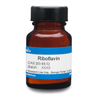Riboflavin is a sparingly soluble (0.085 mg/mL) member of the B vitamins (B2) and serves as a derivative of many flavoproteins in both plants and animals.
It finds potential applications in biochemical redox reactions and may be used as an analytical reference standard to determine the analyte in pharmaceutical formulations via chromatography.
| Mechanism of Action | Riboflavin is a precursor of FAD (flavin adenine dinucleotide); a redox reaction cofactor, and FMN (flavin mononucleotide); an electron carrier involved in photosynthesis. |
| Plant Biology Applications | Riboflavin is used in plant cell culture because of its indirect role in photosynthesis. |
| Molecular Formula | C17H20N4O6 |
| Solubility | Alcohol: Practically insoluble Water: 70 μg/mL |
| References |
Scott, J. M., and Et Al. "Riboflavin, Flavin Mononucleotide, and Flavin Adenine Dinucleotide in Human Plasma and Erythrocytes at Baseline and after Low-dose Riboflavin Supplementation." Clinical Chemistry 48.9 (2002): 1571-577. www.ncbi.gov. Sept. 2002. Web. 4 Sept. 2012. |



